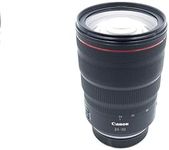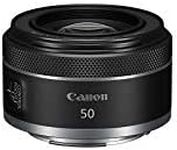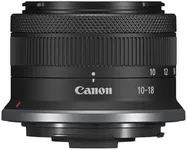Buying Guide for the Best Canon Lens For Video
Choosing the right Canon lens for video can make a huge difference in the look and feel of your footage. The lens affects how much of the scene you capture, how blurry the background appears, and how well your camera performs in different lighting conditions. When picking a lens, think about what kind of videos you want to make—like interviews, travel vlogs, or cinematic short films—and how much flexibility you need in framing your shots. Understanding the key specifications will help you find a lens that matches your creative vision and shooting style.Focal LengthFocal length, measured in millimeters (mm), determines how much of the scene the lens captures and how close or far away subjects appear. Wide-angle lenses (around 10-24mm) capture more of the scene and are great for landscapes or vlogging, while standard lenses (around 35-50mm) offer a natural perspective similar to what the human eye sees, making them good for interviews and general use. Telephoto lenses (70mm and above) bring distant subjects closer and are useful for capturing details or shooting from far away. To pick the right focal length, consider the type of video you want to create and how much space you have to work with—wide angles for tight spaces or immersive shots, and longer focal lengths for close-ups or distant subjects.
ApertureAperture is indicated by an f-number (like f/1.8 or f/4) and controls how much light the lens lets in, as well as how blurry the background appears (depth of field). A lower f-number means a wider aperture, which lets in more light and creates a more pronounced background blur—great for low-light shooting and making your subject stand out. Higher f-numbers let in less light and keep more of the scene in focus. If you often shoot in dim conditions or want a cinematic look with a blurry background, look for lenses with a wide maximum aperture (low f-number). For general use or when you want everything in focus, a lens with a smaller maximum aperture will work fine.
Image StabilizationImage stabilization (IS) helps reduce blurriness caused by shaky hands or movement, which is especially important for handheld video. Some lenses have built-in stabilization, which can make your footage smoother and more professional-looking, especially when shooting without a tripod. If you plan to shoot a lot of handheld video or while moving, a lens with image stabilization can be very helpful. If you mostly use a tripod or gimbal, this feature is less critical.
Autofocus PerformanceAutofocus performance refers to how quickly and quietly the lens can focus on your subject. For video, smooth and silent autofocus is important so that focus changes don’t distract from your footage or add unwanted noise. Some lenses are designed with special motors for quiet and smooth focusing. If you plan to record audio with your camera or need to change focus during a shot, look for lenses known for silent and reliable autofocus. If you prefer to focus manually, this may be less important.
Lens Mount CompatibilityLens mount compatibility means making sure the lens fits your Canon camera. Canon cameras use different mounts, such as EF, EF-S, RF, or EF-M. Using the wrong mount means the lens won’t attach or work properly. Always check which mount your camera uses and choose a lens that matches. If you have a newer mirrorless camera, you may need an RF or EF-M lens, while older DSLRs use EF or EF-S lenses.
Size and WeightThe size and weight of a lens affect how easy it is to carry and use, especially for handheld or on-the-go shooting. Larger, heavier lenses can be tiring to use for long periods, while smaller, lighter lenses are more portable and less noticeable. If you plan to travel, vlog, or shoot for extended periods, a compact and lightweight lens may be more comfortable. For studio or tripod work, size and weight may matter less.














